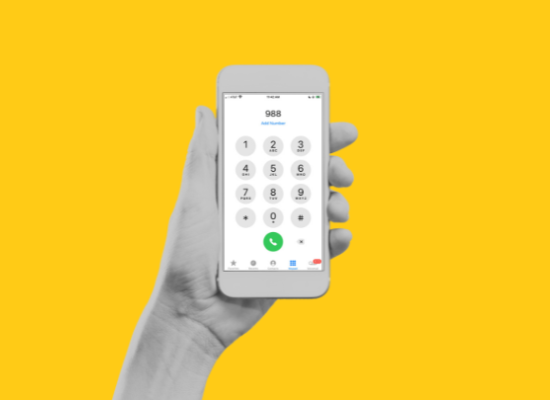
Stephanie Hepburn is a writer in New Orleans. She is the editor in chief of #CrisisTalk. You can reach her at .
It’s no secret that it’s harder, if not impossible, for people to meaningfully engage in mental health treatment when their immediate needs aren’t met, including safe housing, food, money, and transportation. However, there are other common, often related, barriers to care—racism, stigma, lack of culturally competent care, and resource and workforce shortages. Currently, 157 million people live in federally designated mental health workforce shortage areas.
Kaveh Sedehi, founder and CEO of Emissary Health, a digital peer support platform, says peer services help mitigate obstacles to care, including those created or exacerbated by social determinants of health. “People need access to a supportive person with lived experience who can help them troubleshoot and brainstorm. That’s especially true if they’re going through a very tough time and don’t know where else to turn.”
The World Health Organization defines social determinants of health—non-medical factors influencing health equity and outcomes—as “the conditions in which people are born, grow, work, live, and age, and the wider set of forces and systems shaping the conditions of daily life.”
Social determinants of health is a healthcare topic trending in the United States alongside telehealth and closing healthcare disparity gaps, for good reason. According to the office of the assistant secretary for planning and evaluation at the U.S. Department of Health and Human Services, addressing economic stability, neighborhood and built environment, food, community and social context, and access to quality education and healthcare through public support programs (like supported housing) and infrastructure (like public transit) can improve health outcomes and lower healthcare costs.
Sehehi points out that a barrier to care could be as simple as someone not knowing how to take their medication. “They may get a prescription from a provider, fill it at the pharmacy, and still not clearly understand how to take the medication,” he says. “Maybe the nurse or pharmacist didn’t walk them through it, or there was a language barrier because they used medical jargon.”
“A peer may suggest how best to take the medication, potential side effects, and even how long to expect them.”
Peer support is an evidence-based practice that decreases crisis events and hospitalizations. People participating in peer support programs experience improved quality of life, social functioning, and recovery. For example, a pilot study in Canada revealed peers combined with text message support reduced psychiatric readmissions and emergency department visits by 10-25%. In Phoenix, two hospitals found peer support specialists reduced hospital readmission by 56%.
The Emissary Health platform helps peer support specialists provide extra care for clients (complementing face-to-face support). On the health tech app, peers can communicate with their clients—through messaging and video chat, set up evidence-based learning modules, and create goals and a wellness plan. The wellness plan includes a personalized daily to-do list, coping strategies, and contacts. Through the app, clients can also easily schedule a time to meet with their peer support specialist. Modules focus on recovery and whole-person health, highlighting the relationship between mental, physical, and social health.
In March, Dr. Benjamin Druss, Rosalynn Carter chair in mental health at the Emory University School of Public Health, told #CrisisTalk that people can’t achieve mental health without addressing physical health and vice versa. “When people feel better physically, they feel better mentally and emotionally,” he said. He also said peers are vital to overall well-being, calling the active ingredient of peer support the “conveying, communicating, and modeling recovery through their own lived experience.”
Sehehi points out peer support is person-centered and helps address many barriers to care, including logistical ones. “They can help the person figure out how to get transportation vouchers or set up an appointment with a primary care provider,” he says. “Having someone to turn to who’s gone through the process makes it more likely that they’ll be able to get to their appointment.” A touchpoint with a provider can help protect the person from rehospitalization.
On the backend of the Emissary Health app is not only powerful software that helps peers provide services through video and texting support but also features artificial intelligence algorithms that can help peers predict a client’s crisis before it happens. For example, specific phrases help peer support specialists identify if their clients are experiencing a worsening mood, hopelessness, or worsening anxiety. Wording like “relapse,” “started using again,” “been drinking more,” and “overdose” are risk factors that the person might be, or is on the cusp of, experiencing a substance use crisis. The app will then alert the peer support specialist of the person’s increased or increasing risk.
“The peer will immediately reach out to the person,” says Sedehi, “and determine if the person needs a higher level of care or additional supports to avoid an adverse event like hospitalization.”
So far, Medicaid in three states—Indiana, Minnesota, and Rhode Island—pay for providers to use the Emissary Health app. Healthcare providers can use the software infrastructure to orient, engage, and deploy peer support specialists. “It creates a means to better provide care for people facing mental health and substance use challenges,” says Sedehi.
According to June 2022 data, over 89 million people are enrolled in Medicaid and CHIP. Eligibility is typically based on someone’s modified adjusted gross income, though there are exceptions. Because many enrollees face social determinants of health challenges, Medicaid has become increasingly focused on strategies to address social needs that affect outcomes. (A 2021 study published in the Journal of Primary Care and Community Health revealed that commercially insured populations also commonly experience social determinants of health barriers.)
However, getting payor support is no easy feat. That’s why the Emissary Health business case and pitch focus on how the app addresses pain points for insurers. “Medicaid has complex behavioral health populations,” says Sedehi, “and the average cost for these populations is high in terms of service use and hospital use.”
“We know peer support services decrease hospital length of stay, rehospitalization, and increase medication adherence.” Yet, when not addressed, all three drive high financial costs to insurers. (SAMHSA’s National Guidelines for Behavioral Health Crisis Care highlight that significant use of peers must be “baked into” the crisis care system.)
The Covid pandemic and 988—the nationwide three-digit number for mental health, suicidal, and substance use crises—have resulted in expanded legislation and funding for behavioral healthcare and, correspondingly, increased digital innovation. Yet, most health tech companies haven’t focused on peer workforce or its services. Sedehi points out that with increased behavioral health needs, peer support services are more critical than ever. “People experiencing behavioral health challenges highly benefit from peer wraparound care and support,” he says.
Currently, Medicaid pays providers to use the Emissary Health app as part of their care management post-discharge from the emergency department or inpatient hospitalization. “That’s not far enough upstream,” says Sedehi. So as the company grows, he hopes to partner with call centers and outpatient, respite, and 23-hour crisis stabilization providers. “We want to collaborate and ensure people don’t slip through the cracks.”









